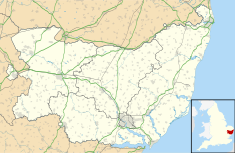Orford Town Hall
| Orford Town Hall | |
|---|---|
 The building in 2022 | |
| Location | Market Hill, Orford |
| Coordinates | 52°05′40″N 1°32′03″E / 52.0945°N 1.5341°E |
| Built | 1902 |
| Architect | Harry Sirr and Edwin Rope |
| Architectural style(s) | Edwardian Baroque style |
Listed Building – Grade II | |
| Official name | Town Hall |
| Designated | 16 January 1984 |
| Reference no. | 1198392 |
Orford Town Hall is a municipal building on Market Hill in Orford, a town in Suffolk, in England. The building, which currently accommodates the offices and meeting place of Orford and Gedgrave Parish Council, is a Grade II listed building.[1]
History
The first municipal building in the town was an ancient town hall. It was a small building which accommodated meetings of the borough officials as well as the petty session hearings.[2] Orford had a very small electorate and a dominant patron, Francis Seymour-Conway, 3rd Marquess of Hertford, which meant it was recognised by the UK Parliament as a rotten borough.[3] Its right to elect members of parliament was removed by the Reform Act 1832,[4] and its borough council, which had met in the town hall, was abolished under the Municipal Corporations Act 1883.[5] Its assets were subsequently transferred to a specially formed entity, the Orford Town Trust.[6]
In the late 19th century, parish officials decided to commission a new town hall. The new building was designed by Harry Sirr and Edwin Rope in the Edwardian Baroque style, built in red brick and was completed in 1902.[7][8][9] The design involved a symmetrical main frontage facing onto Market Hill. There was an opening on the ground floor (which was later enhanced by a wide porch), a five-light mullioned and transomed window on the first floor and a niche in the stepped gable above. Internally, the principal room was the main assembly hall.[1]
During the First World War, an armament experimental station was established at Orford Ness and, due to the lack of adequate accommodation at Orford Ness, the station headquarters was formed in the town hall. [10] Later, the town hall was used for concerts: a rehearsal of the one-act opera, Noye's Fludde, by the British composer, Benjamin Britten, took place there in 1958.[11]
In October 2008, an exhibition was held in the town hall to celebrate the 60th anniversary of the return of the residents of Sudbourne and Iken to their homes after the area had been used for training by 79th Armoured Division during the Second World War.[12] In February 2014, a not-for-profit entity was established to arrange weekly film shows in the town hall,[13] and it also continued to host meetings of the Orford and Gedgrave Parish Council.[14]
The art collector, Sir Richard Wallace, 1st Baronet, who lived at Sudbourne Hall and who established the Wallace Collection, commissioned three large oil paintings by the French artist, Alfred Charles Ferdinand Decaen, depicting his shooting parties (On Sudbourne Hill (1874); Shooting Luncheon at the Great Wood Sudbourne (1876); Battue de perdreaux dans la comté de Suffolk (1880)), all of which are now displayed in the town hall.[15]
References
- ^ a b Historic England. "Town Hall (1198392)". National Heritage List for England. Retrieved 27 May 2024.
- ^ White, William (1855). History, gazetteer, and directory, of Suffolk. p. 517.
- ^ "When East Anglian politics was really 'rotten'". Eastern Daily Press. 27 April 2010. Retrieved 27 May 2024.
- ^ "The History of Politics: The Rotten Boroughs of England". Julia Herdman Books. 21 April 2017. Retrieved 27 May 2024.
- ^ Municipal Corporations Act 1883 (46 & 46 Vict. Ch. 18) (PDF). 1883. Retrieved 21 December 2021.
- ^ Return from the Authorities for the Harbours. House of Commons. 10 August 1903. p. 77.
- ^ "Orford Town Hall Leaflet" (PDF). Orford Town Trust. p. 2. Retrieved 27 May 2024.
- ^ "Orford Conservation Area Appraisal" (PDF). East Suffolk Council. 1 June 2010. p. 27.
- ^ The Architectural Review Congress Number In Connection with the International Congress of Architects in London, July 1906 : Comprising A Summary of English Medieval Architecture. Royal Institute of British Architects. 1906. p. 138.
Orford Town Hall, Suffolk. Harry Sir and E. J. Rope, architects
- ^ Gunn, Peter B. (2017). Aviation Landmarks – Norfolk and Suffolk. History Press. ISBN 978-0750986557.
- ^ Kendall, Alan (1973). Benjamin Britten Introduction by Yehudi Menuhin. Macmillan Publishing. p. 52. ISBN 978-0333152263.
I heard the Fludde again at a rehearsal at Orford Town Hall
- ^ "Understanding Britain's Atlantic Walls" (PDF). A Dunblane Museum Project. p. 25. Retrieved 27 May 2024.
- ^ "Orford: Community cinema to screen classic love story". East Anglian Daily Times. 25 February 2014. Retrieved 27 May 2024.
- ^ "Parish Council Meeting" (PDF). Orford and Gedgrave Parish Council. 18 January 2012. Retrieved 27 May 2024.
- ^ "The Sudbourne Hall Estate" (PDF). Rendlesham Parish Magazine. 1 March 2021. p. 6. Retrieved 27 May 2024.

